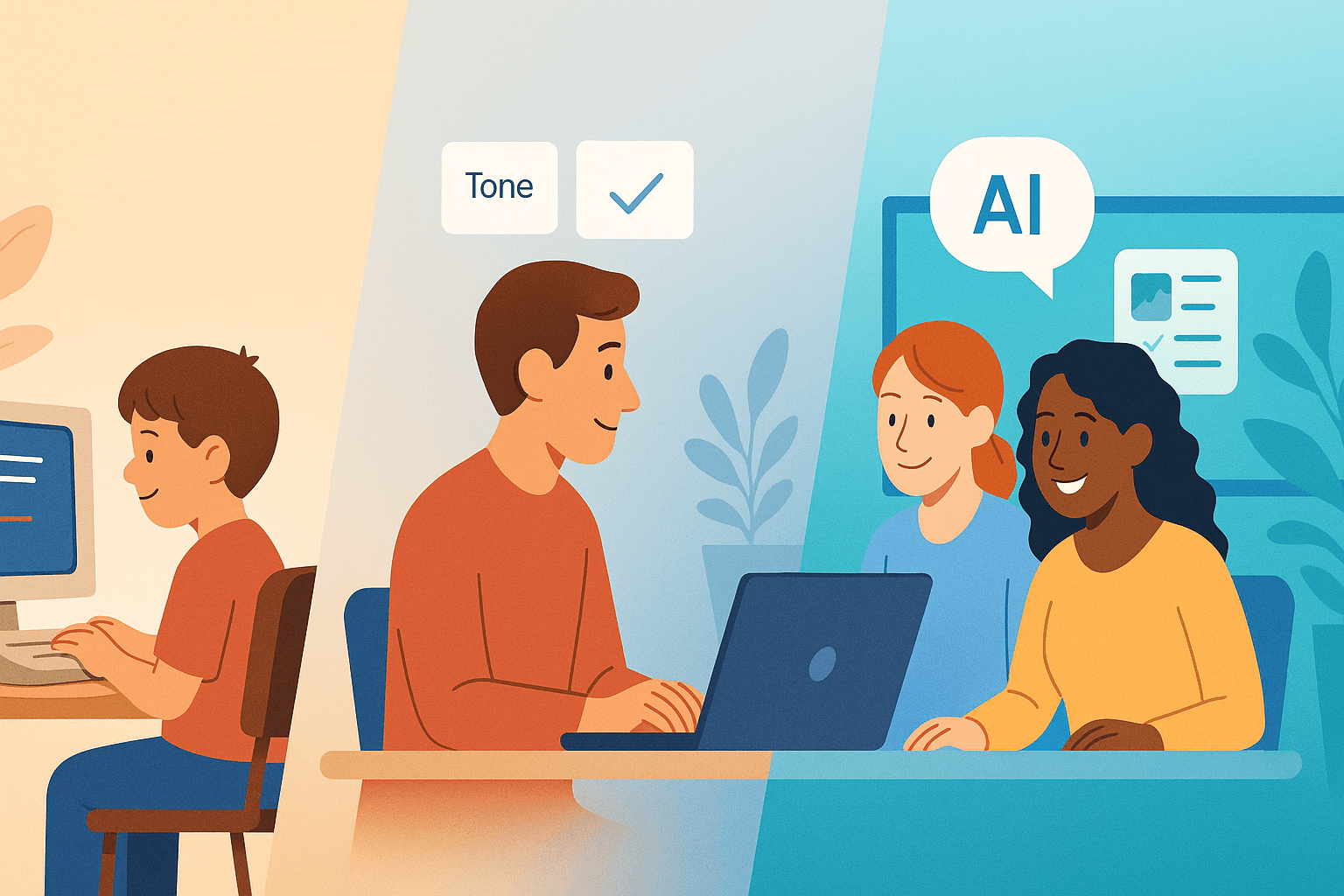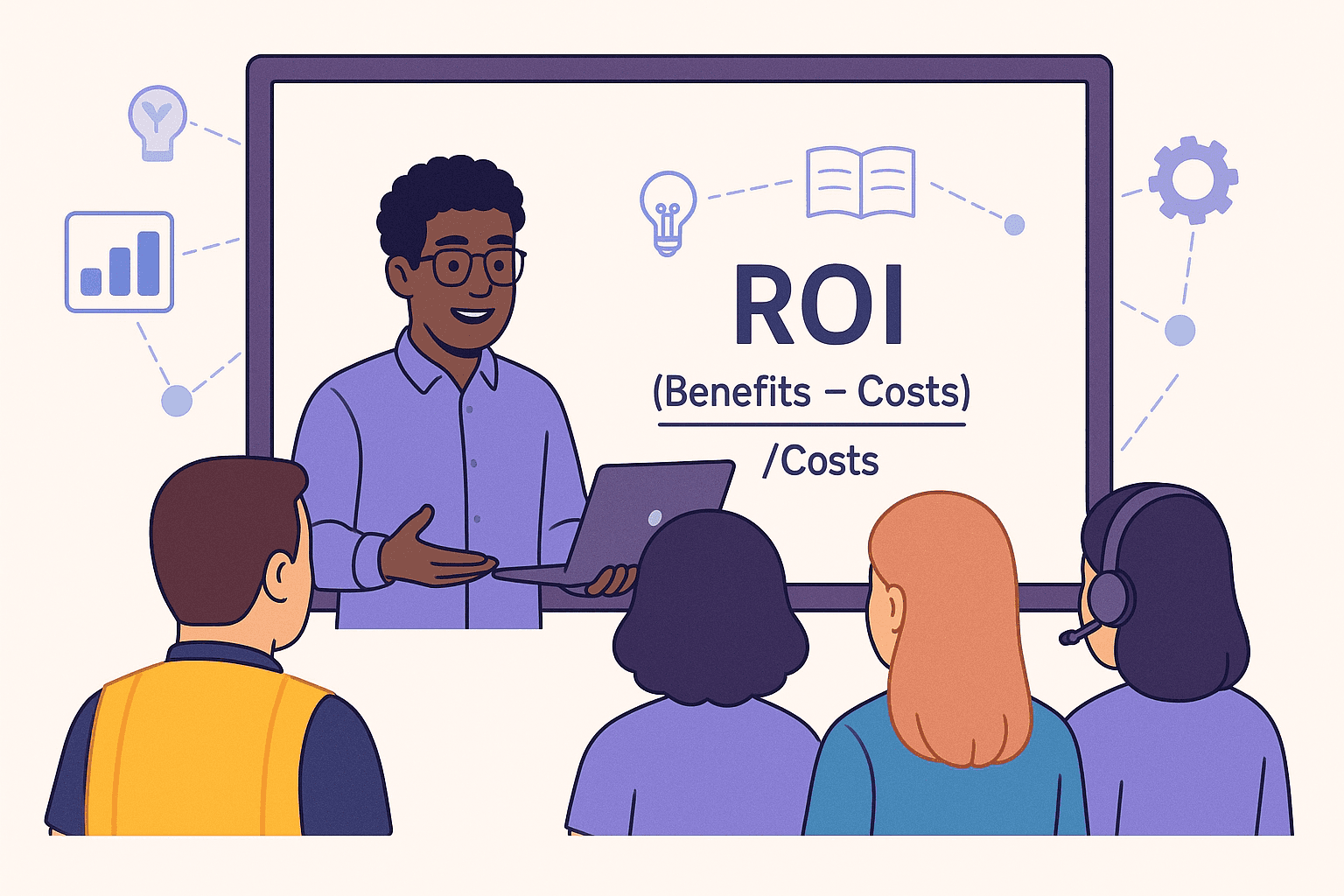5 min
Jun 24, 2024
How can L&D teams use AI within the context of the ADDIE model?
Coleman Numbers

Introduction
What does it look like to use AI in L&D?
Recently, this blog has mostly been concerned with more basic questions about AI in learning—how does machine intelligence interfere with or augment the human mind? What are the moral and cultural dangers of using these tools discriminately? How can AI promote human flourishing in the workplace?
In this post, however, I want to tackle a much more concrete question: what are the specific ways we can use generative AI to make L&D teams work better? Or, put another way: why should companies invest in integrating AI with training processes?
Short answer: integrating generative AI into L&D processes can significantly enhance the creation, delivery, and evaluation of training materials. To show how this can be done, we’ll take a look at the ADDIE model (Analysis, Design, Development, Implementation, Evaluation), and discuss how L&D professionals can systematically harness the power of AI to drive success in their training initiatives.
We’ll start by talking about that integration in general and then wrap up by touching on how Mindsmith, specifically, introduces AI at each stage of ADDIE.
The ADDIE Model and AI
Analysis
Developing a productive training begins with “[identifying] the gap between the actual and desired skills” of an organization. AI can help accomplish this at the large and small scales.
At the large scale, AI can analyze organizational data to identify specific training needs, allowing L&D teams to focus on areas that will have the most impact. Predictive analytics tools can forecast future skills gaps, enabling proactive planning. Additionally, AI can help understand learner motivations and barriers through data analysis, providing insights that inform more effective training strategies.
More importantly, and more personally, at the small scale, AI can speed up the process of identifying the individual needs of learners. Imagine, for example, an “AI interviewer” that can guide employees through self-reflection and assessment, helping them and an organization identify areas for potential growth.
Design
After the needs of learners are understood, learning content has align with those needs. All the bells and whistles of a fancy LMS, AI-powered or otherwise, are meaningless if they aren’t driven towards developing skills.
AI is most directly useful at this stage of the process as an information integrator—an agent that can take interviews, surveys, and other data gathered in the analysis stage and propose rough outlines of how content should be arranged. These outlines can then be refined by human editors.
Development
AI accelerates the development process by generating diverse content types, such as text, videos, and quizzes. Platforms that use AI to create interactive simulations and microlearning modules enhance the learning experience. Furthermore, AI enables rapid prototyping and A/B testing, continuously refining content based on data-driven insights.
For L&D professionals, this capability means a shift from tactical, lower-order grunt work to strategic, higher-order design thinking. AI tools minimize the opportunity cost of experimentation and expand the space of possible learning content. And once features like video generation come online, this space will only broaden.
Implementation
One of the most promising aspects of AI-driven platforms is the ability to adjust content in real-time based on learner progress, personalizing the learning experience. Tools that deploy behavioral interventions, such as nudges and personalized feedback, further enhance engagement and motivation. This real-time adaptation helps training materials stay relevant and effective.
Evaluation
AI provides insights into learner performance and training effectiveness through analytics and reporting features. By recommending adjustments based on real-time data, AI supports continuous improvement of training programs; this data-driven approach also ensures that L&D initiatives are aligned with organizational goals and learner needs.
Right now, lots of companies are building bespoke predictive analytics solutions around AI—but to get started you don’t necessarily need one. Anyone with a subscription to OpenAI’s ChatGPT Premium service can upload files to ChatGPT and perform data analysis, visualization, and talk with ChatGPT about insights from that data. And the Enterprise version of the product makes this scalable.
This means that L&D professionals with minimal experience in data science now have individual access to an AI data science assistant—someone who will help them make empirically informed design decisions.
How Mindsmith Uses ADDIE
Mindsmith is being built with every stage of the ADDIE model in mind. Specifically, we aim to introduce AI in ways that enhance and are complementary to the work L&D professionals already do.
Analysis
From the very start, Mindsmith’s lesson generator has the learner in mind. The interface is designed to give creators maximum flexibility in creating lesson modules, with fields that can prime the generator to pay attention to considerations of context, length, content type, style, and audience.
Additionally, part of Mindsmith’s long-term roadmap is an AI assistant that’s sensitive to a learner’s identity—in the future, we’ll make that AI interviewer we mentioned above an extremely useful reality. Learners on the platform will enter lessons having already taught the lesson’s adaptive AI about themselves. As we’ll see at later stages of the ADDIE process, this will mean more meaningful and more lasting learning.
Design
Mindsmith’s outline tool accomplishes the exact functionality discussed earlier. After a creator offers the lesson generator some initial information about the parameters of a given lesson, Mindsmith will generate a broad outline that then becomes the basis for the whole lesson module. Creators can easily edit and add more detail to this outline to suit their instructional needs.
Development
AI lesson assistant can generate a lesson from scratch based on customized instructions about audience and style as well as existing documents. Within the editor, you can continue to collaborate with the AI assistant by requesting the insertion of specific types of images and the redesigning of individual slides or whole sections of a lesson.
Implementation
Real-time personalization is at the center of Mindsmith’s long-term vision. Training content that is easy to produce and refine will also become personalized on a granular level. This amounts to more than just rearranging premade blocks of content. An AI tutor or coach that knows about a particular learner’s love of 19th century nature paintings, for example, can create comprehension questions that leverage this interest. More critically, perhaps, an AI coach will, with the right context, understand an individual’s learning style and present content in a way that matches that style.
Evaluation
Mindsmith already offers detailed analytics on learner success; in the future, we plan on adding AI-powered recommendations on what to do with that data. This means that L&D teams will have more time to design and implement adjustments to training programs more quickly.
Conclusion
As Josh Bersin, a leading HR and corporate training analyst, noted last year, we “can’t stop the freight train from coming.” AI is arriving in force across every industry, every domain, and every part of life. The learning and development professionals who thrive in the future will be the ones who understand how to use AI—especially generative AI—at every step of their process.
This entails a revolution in the way L&D do their work. It means a new type of data literacy—a propensity for every member of a team to understand and draw independent insights from AI-driven analytics. It means a change in the scope of most designers’ work—the average L&D professional will be, as in so many other fields, more of an editor than a writer, as New York Times columnist Ezra Klein has written. And it means that the deployment of corporate learning will be more personalized—and hopefully more effective—than ever.



